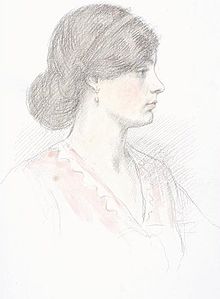Brian Hatton
Brian Hatton (born August 12, 1887 in Hereford , † April 23, 1916 in Oghratina , Egypt ) was a British painter who was assigned to realism .
origin
His parents were Alfred Hatton (1856-1933) and his wife Amelia Keay (1864-1909). He still had two sisters Ailsa Marr (1893-1949) and Marjorie (1895-1981). Like his grandfather, his father worked in the leather trade.
Life
Even as a boy he showed his extraordinary talent for painting. In 1895 he received the bronze medal of the Royal Drawing Society (RDS) by the artist George Frederic Watts . Watts began to promote him and in 1898 he received the gold medal from Princess Louise . He began to be interested in portraits and often drew his younger siblings, but also painted for the princess who invited him and his mother to Kensington Palace .
From 1899 to 1902 he went to the Grammar School in Swansea, where he was given extra time to paint. From 1905 to 1906 he went to Trinity College in Oxford . At the time, Princess Alice invited him to draw her children at Windsor Castle . With financial help from his uncle Charles Marr, he went to the Art School Hospitalfield House in Arbroath for a year . Then he went to St Ives and Newlyn and then together with his uncle to Amsterdam and The Hague to learn from other artists.
Around 1908 he returned to Herefordshire and opened a studio where he began as a portrait painter. In 1908 he was able to take part as a draftsman on the Flinders Petrie Expedition to Egypt. In 1910 he went to the Académie Julian in Paris , where one of his works was exhibited in the Paris Salon .
He returned to Great Britain but went to London to see his cousin Geoffrey Vevers and opened a studio with Gerald Siordet whom he knew from Oxford. He was able to place one of his pictures in the summer exhibition of the Royal Academy of Arts in 1914 . The picture was received with admiration by the Royal Institute of Oil Painters , and Hatton was named a member. By John Masefield , he was commissioned the book The Everlasting Mercy to illustrate. In the same year he went to Paris again and then went on vacation with his uncle in Belgium . On his return the First World War was imminent and he was enlisted in the Worcester yeomanry on September 4, 1914 . One month later on November 5, 1914, he married his girlfriend, the dance teacher Lydia May Bidmead (* 1888). Hatton was trained as a telecommunications operator ( signaler ) and rose to become second lieutenant. He was transferred to Egypt shortly after the birth of his daughter because he knew the country and the language from his previous stay. On April 23, 1916, he was with a pioneer troop who were to create a well near Oghratina when they were surprised by Turkish troops. Hatton was the best rider in the company and was supposed to get reinforcements, but he was shot. His body was later recovered and buried in the military cemetery in El Qantara . Oghratina is near Katia on the Sinai Peninsula on the Mediterranean coast.
estate
Despite his short life, Hatton left behind more than 1,000 works of various kinds. After his death, there were two important exhibitions of his work in Walker's Gallery in 1926 and in Leighton House in 1955 . Most of his work was given to the Hereford Museum by the widow . His sister Marjorie in particular did a great job for his memory. She founded the Brian Hatton Trust to finance the permanent exhibition of his works.
family
He married Lydia May Bidmead (* 1888; † 1984) on November 5, 1914 . The couple had a daughter:
- Mary Amelia (September 1915; † 1980 Illinois, USA), dancer ∞ Cecil Shaler (1904–1962)
The widow married Angus Wilson from Hereford in 1930, and later moved to Illinois to live with her daughter, where she also died.
literature
- Celia Davies, Brian Hatton: a biography of the artist (1887–1916) , ISBN 978-0-900963-84-1
- Walter Shaw Sparrow, 'Brian Hatton: young painter of genius killed in the war', Walker's Quarterly, 17, (February 1926)
- A. Jarman ea, Royal Academy exhibitors, 1905–1970: a dictionary of artists and their work in the summer exhibitions of the Royal Academy of Arts , 6 vols. (1973–1982)
Web links
- Oxford Dictionary of National Biography
- family
- 101 paintings by Hatton at bbc.co.uk
- Biography herefordshire.gov.uk
- Geoffrey Vevers
- Mary Hatton
- Brian Hatton Trust
- Worcestershire Yeomanry
| personal data | |
|---|---|
| SURNAME | Hatton, Brian |
| BRIEF DESCRIPTION | British painter |
| DATE OF BIRTH | August 12, 1887 |
| PLACE OF BIRTH | Hereford |
| DATE OF DEATH | April 23, 1916 |
| Place of death | Oghratina , Egypt |

